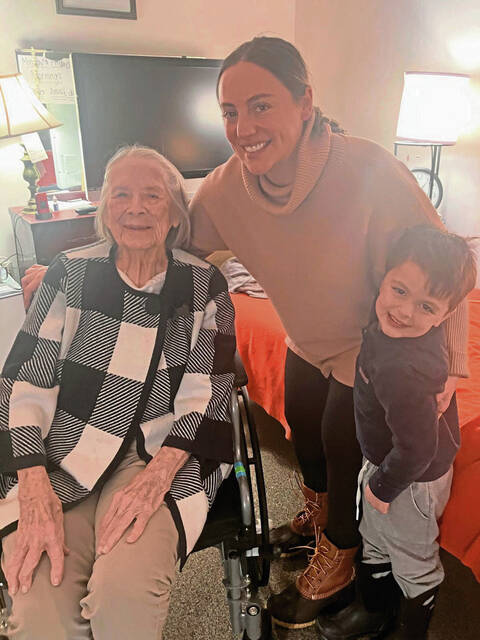https://triblive.com/local/monroeville/veteran-service-group-organizes-birthday-card-campaign-for-wwii-code-breaker-living-in-monroeville/
Veteran service group organizes birthday card campaign for WWII code breaker living in Monroeville

There is never a good time for war. But for Julia Parsons, the outbreak of World War II came at the right time.
In 1942, Parsons was a senior at Carnegie Tech — soon to be Carnegie Mellon University — “about to graduate with a General Studies degree that equipped me to do practically nothing in the real world,” she said.
After working a few months that summer in an Army ordnance lab checking gauges on shells manufactured in Pittsburgh’s steel mills, Parsons saw a newspaper article about the U.S. Navy accepting women into service as commissioned officers for the first time.
In short order, Parsons would become a member of the Navy’s WAVES program — which stood for “Women Accepted for Volunteer Emergency Service” and would rapidly go on to become a code breaker, deciphering transmissions sent from the German military to U-boats in the North Atlantic.
Parsons will turn 104 years old on March 2, and a local nonprofit veteran service group is hoping to organize a very happy birthday for her through a birthday card campaign.
Anyone who’d like to wish Parsons a happy birthday can send a card to Julia Parsons, Room 201, 4363 Northern Pike, Monroeville, Pa., 15146.
Parsons underwent Naval Reserve Midshipmen’s School at Smith College in New England, focusing on cryptology. Having taken two years of German language classes in high school, she was immediately assigned to the Enigma section. In October 1942 the British military had gotten its hands on Enigma, the German encryption machine along with three months’ worth of codes, after capturing U-559.
“It looked like a typewriter in a small wooden cabinet,” Parsons said of the Enigma machine. “Inside the cabinet is where Enigma worked its diabolical (to us) magic. Each key on the typewriter was wired to a wheel, and each wheel to another wheel, and then to two others — four wheels in all. Each wheel changed the letter that went into it, so that the letter that was typed went through four generations of change before outputting as a seemingly random letter. The wheels were removable and could be rearranged, and their alphabet settings could also be changed, and they were, every 12 hours.”
The morning code was never the same as the afternoon code. The only rule was that the outputted letter could never match the inputted letter. It was a safety measure the Germans had built into Enigma, but it helped code-breakers such as Parsons eliminate plausible but false messages.
Once the three months’ worth of code in Allied hands ran out, they were back to square one.
“Every once in a while, we’d catch a break. U-boats sometimes lost radio contact, and when they’d surface to recharge their batteries, they’d radio their base requesting that missed messages be resent,” Parsons said. “Sometimes we’d be able to match these recoded messages against messages sent in the old code we’d broken. When that happened, it was like picking a lock and opening a door to a room full of useful information.”
A break came when Parsons was working on a spreadsheet containing all the German transmissions intercepted over the past six months — she noticed that every night at 7:30 p.m., a German control center sent a weather report for the Bay of Biscay off the western coast of France.
The break? The wording was nearly the same every night, which was forbidden in any code operation. Parsons said the sender even failed to use misleading “dummy words” at the beginning of the messages.
“Because we knew the message content, we could work backwards and figure out the afternoon code,” she said. “We’d simply wait until 7:30 p.m., receive the message, break the code, and then work like mad deciphering the messages we’d received earlier that day. We did this from the time I made the spreadsheet until the end of the war. It was our permanent solution to the problem of the code.”
After the war, Parsons was among thousands of U.S. women who lost their jobs. For volunteers such as Parsons, the war’s end meant the end of her work at the Naval Communications Annex. For civilian women, it meant giving up their jobs so that returning U.S. servicemen could reclaim them.
Despite meeting her husband during her time in the military, Parsons was never able to tell him about her work. It was classified until the 1970s, and Parsons herself didn’t know she could discuss it until 1997. During a trip to the National Cryptologic Museum near Fort Meade, Md., where she discovered her work had been declassified.
“All those years of silence, I think, did a disservice to history,” she said. “The museum exhibits were riddled with small errors about details that were vitally important to us.”
In her 40s, Parsons earned her teaching certificate and taught English briefly in the North Allegheny School District, before her husband’s work as an Army engineer took them overseas.
In addition to the birthday card campaign, Veterans Breakfast Club officials also encouraged the public to visit with Parsons, which can be arranged through her veteran advocate Sue Watson by calling 412-977-6451.
Copyright ©2026— Trib Total Media, LLC (TribLIVE.com)
